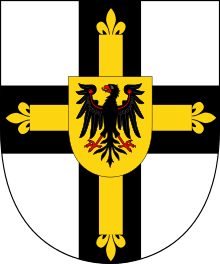Grand Master of the Teutonic Order
| Grandmaster of Teutonic Order
Hochmeister | |
|---|---|
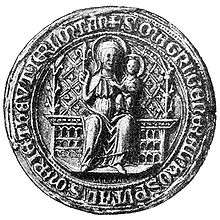 The seal of the Grand Master of the Teutonic Order (Sigillum Magistri Generalis Hospitalis Sancte Marie Theutonicorum Ier(oso)l(o)m(i)tan(i). This seal was in use for more than 200 years, from the 13th century until it was replaced by Frederick, Duke of Saxony in 1498.[1] | |
| Reports to | Holy See |
| Term length | Life tenure |
| First holder | 1219 |
| Part of a series on the |
| Hierarchy of the Catholic Church |
|---|
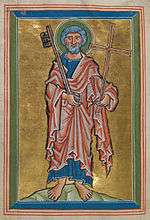 |
| Ecclesiastical titles |
|
|
Liturgical titles |
|
Administrative and pastoral titles
|
|
Consecrated and professed titles |
|
|
The Grand Master (German: Hochmeister; Latin: Magister generalis) is the holder of the supreme office of the Teutonic Order. It is equivalent to the grand master of other military orders and the superior general in non-military Roman Catholic religious orders. Hochmeister, literally "high master", is only used in reference to the Teutonic Order, as Großmeister ("grand master") is used in German to refer to the leaders of other orders of knighthood.
An early version of the full title in Latin was Magister Hospitalis Sanctae Mariae Alemannorum Hierosolymitani. Since 1216, the full title Magister Hospitalis Domus Sanctae Mariae Teutonicorum Hierosolymitani ("Master of the Hospital House of the Blessed Virgin Mary of the Germans of Jerusalem") was used.
The offices of Hochmeister and Deutschmeister (Magister Germaniae) were united in 1525. The title of Magister Germaniae had been introduced in 1219 as the head of the bailiwicks in the Holy Roman Empire, from 1381 also those in Italy, raised to the rank of a prince of the Holy Roman Empire in 1494, but merged with the office of grand master under Walter von Cronberg in 1525, from which time the head of the order had the title of Hoch- und Deutschmeister.[2]
Coat of arms
The coat of arms representing the grand master (Deutschmeisterwappen) is shown with a golden cross fleury or cross potent superimposed on the black cross, with the imperial eagle as a central inescutcheon. The golden cross fleury overlaid on the black cross becomes widely used in the 15th century. A legendary account attributes its introduction to Louis IX of France, who on 20 August 1250 granted the master of the order this cross as a variation of the Jerusalem cross, with the fleur-de-lis symbol attached to each arm. While this legendary account cannot be traced back further than the early modern period (Christoph Hartknoch, 1684) there is some evidence that the design does indeed date to the mid 13th century.[3]
Before the Reformation
Compared to other medieval governments, transfer of power within the Teutonic Knights was run efficiently. Upon the death of a grand master, the vice master called a capitulum of the leading officers of the order. The general chapter would select a twelve-person electoral college composed of seven knights, four sergeants, and one priest. Once a majority-candidate for grand master was chosen, the minority electors would concede to support unanimity. These elections usually provided a succeeding grand master within three months.[4]
Candidates for the position of grand master had experience as senior administrators for the order and were usually chosen on merit, not lineage.[5] This changed only after the order had entered a steady decline, with the selection of Frederick of Saxony and Albert of Brandenburg-Ansbach, members of the powerful Wettin and House of Hohenzollern dynasties.
When the Teutonic Knights were originally based in Acre in Outremer, the grand masters spent much of their time at the papal and imperial courts.[6] The grand masters were most powerful after the order's 13th century conquest of Prussia during the Northern Crusades and the creation of the militarized State of the Teutonic Order (Ordenstaat), which lasted until 1525. After the order's capital moved from Venice to Marienburg in 1309, the grand master's power was at its height. He had ultimate control over Prussia, which gave him command over the Prussian commanders. When the general chapter would meet in Elbing, he was able to use this influence to ratify administrative measures he proposed.[5] The grand master also served as the castellan of Marienburg and was aided by the order's treasurer. He was also a member of the Hanseatic League, allowing him to receive some of the league's custom dues.[7]
Excavations in the church of Kwidzyn (Marienwerder) performed in 2007 yielded the skeletal remains of three Grand Masters of the late medieval period, Werner von Orseln (1324–30), Ludolf König (1342–45) and Heinrich von Plauen (1410–13). The church had been known as the burial place of the bishops of Pomesania, but the discovery of the grand masters' burials was unexpected. The bodies had been buried in gold-painted wooden coffins draped in silk robes.[8]
Leaders of the early Brotherhood, 1190–1198
The Teutonic Order as a hospice brotherhood in Outremer:
- 1190 Master Sibrand
- 1190—1192 Konrad
- 1192 Gerhard
- 1193/94 Heinrich, prior
- 1195–1196 Ulrich
- 1196 Heinrich, preceptor (probably identical with Heinrich Walpot, the first Grand Master-see below; German article at Heinrich Walpot von Bassenheim)[9]
Grand Masters of the Order, 1198–1525

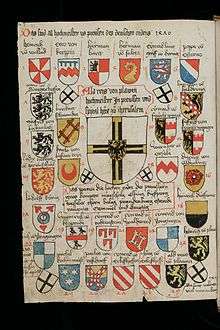
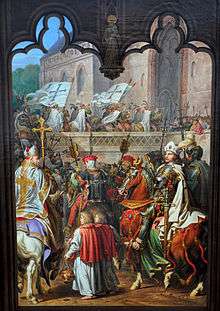
The Teutonic Order as a spiritual military order had a total of 37 grand masters between 1198 and 1525.
Several armorials of the 15th and early 16th century depict the coat of arms of the grand masters. These include the Chronica by Ulrich Richenthal,[10] an armorial of St. Gallen kept in Nuremberg,[11] an armorial of southwest Germany kept in Leipzig[12] and the Miltenberg armorial.[13] Conspicuously absent from these lists are three grand masters, Gerhards von Malberg (1241-1244) and his successors Heinrich von Hohenlohe (1244-1249) and Gunther von Wüllersleben (1250-1252), so that pre-modern historiographical tradition has a list of 34 grand masters for the time before 1525 (as opposed to 37 in modern accounts).[14]
- 1. 1198–sometime before 1208 Heinrich Walpot von Bassenheim[9]
- 2. documented for 1208 Otto von Kerpen[9]
- 3. 1208–1209 Heinrich von Tunna
- 4. 1209–1239 Hermann von Salza. As a friend and councillor of emperor Frederick II, Hermann achieved the recognition of the order as of equal status with the older military orders of the Knights Hospitaller and the Knights Templar by Pope Honorius III. In 1237, he also oversaw the incorporation of the Livonian Brothers of the Sword into the Teutonic order.
- 5. 1239–1240 Konrad von Thüringen
- (6.) 1240–1244 Gerhard von Malberg
- (7.) 1244–1249 Heinrich von Hohenlohe
- (8.) 1249–1252 Günther von Wüllersleben
- 6. (9.) 1252–1256 Poppo von Osterna (the pretender Wilhelm von Urenbach (1253-1256) was chosen in opposition to Poppo von Osterna).[15]
- 7. (10.) 1256–1273 Anno von Sangershausen
- 8. (11.) 1273–1282 Hartmann von Heldrungen
- 9. (12.) 1282 or 1283 –1290 Burchard von Schwanden[16]
- 10. (13.) 1290–1297 Konrad von Feuchtwangen. After the fall of Acre, Konrad moved the Order's headquarters to Venice.
- 11. (14.) 1297–1303 Gottfried von Hohenlohe
- 12. (15.) 1303–1311 Siegfried von Feuchtwangen, of the same family as his pre-predessor Konrad von Feuchtwangen. Siegfried moved the order's headquarters to Prussia in 1309.
- 13. (16.) 1311–1324 Karl von Trier
- 14. (17.) 1324–1330 Werner von Orseln
- 15. (18.) 1331–1335 Luther von Braunschweig (Lothar)
- 16. (19.) 1335–1341 Dietrich von Altenburg
- 17. (20.) 1342–1345 Ludolf König
- 18. (21.) 1345–1351 Heinrich Dusemer[17]
- 19. (22.) 1351–1382 Winrich von Kniprode
- 20. (23.) 1382–1390 Conrad Zöllner von Rothenstein
- 21. (24.) 1391–1393 Konrad von Wallenrode
- 22. (25.) 1393–1407 Konrad von Jungingen
- 23. (26.) 1407–1410 Ulrich von Jungingen
- 24. (27.) 1410–1413 Heinrich von Plauen
- 25. (28.) 1414–1422 Michael Küchmeister von Sternberg
- 26. (29.) 1422–1441 Paul von Rusdorf
- 27. (30.) 1441–1449 Konrad von Erlichshausen
- 28. (31.) 1449 or 1450–1467 Ludwig von Erlichshausen[18]
- 29. (32.) 1467–1470 Heinrich Reuß von Plauen
- 30. (33.) 1470–1477 Heinrich Reffle von Richtenberg
- 31. (34.) 1477–1489 Martin Truchseß von Wetzhausen
- 32. (35.) 1489–1497 Johann von Tiefen
- 33. (36.) 1497–1510 Frederick, Duke of Saxony
- 34. (37.) 1510–1525 Albert of Brandenburg-Ansbach, Duke of Prussia
After the Reformation
Grand Master Albert of Brandenburg-Ansbach converted to Lutheranism and turned the Ordenstaat into the secular, Lutheran Duchy of Prussia in 1525. The Teutonic Order retained its holdings in Germany and autonomous Livonia, however. Due to being limited to their possessions in other parts of Germany, which were led by the Deutschmeister, the titles Hochmeister and Deutschmeister were combined during the reign of Walter von Cronberg, who was appointed by Emperor Charles V. This dual-title lasted until 1923. For centuries the "Jägerregiment Wien" of the Military of Austria was known as the "Hoch- und Deutschmeister Regiment".
Hoch- und Deutschmeister, 1530–1929
- 1527–1543 Walter von Cronberg
- 1543–1566 Wolfgang Schutzbar
- 1566–1572 Georg Hundt von Weckheim
- 1572–1590 Heinrich von Bobenhausen
- 1590–1618 Maximilian of Austria
- 1619–1624 Karl I of Austria
- 1625–1627 Johann Eustach von Westernach
- 1627–1641 Johann Kaspar von Stadion
- 1641–1662 Archduke Leopold Wilhelm of Austria
- 1662–1664 Archduke Karl Josef of Austria
- 1664–1684 Johann Caspar von Ampringen
- 1685–1694 Ludwig Anton of Palatinate–Neuburg
- 1694–1732 Ludwig Franz of Palatinate–Neuburg
- 1732–1761 Prince Clemens August of Bavaria
- 1761–1780 Prince Charles Alexander of Lorraine
- 1780–1801 Archduke Maximilian Franz of Austria
- 1801–1804 Archduke Charles, Duke of Teschen
- 1804–1835 Archduke Anton Victor of Austria (office becomes hereditary to Imperial House of Austria)
- 1835–1863 Archduke Maximilian of Austria–Este
- 1863–1894 Archduke Wilhelm Franz of Austria
- 1894–1923 Archduke Eugen of Austria (end of hereditary status)
- 1923–1929 Norbert Klein
1929 – present-day
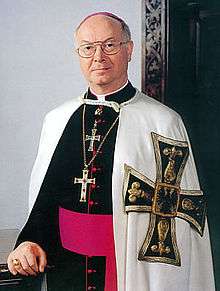
Time of the Teutonic Order as a clerical Roman Catholic religious order
- 1929–1933 Norbert Klein
- 1933–1936 Paul Heider
- 1936–1948 Robert Schälzky
- 1948–1970 Marian Tumler
- 1970–1988 Ildefons Pauler
- 1988–2000 Arnold Othmar Wieland
- 2000–present Bruno Platter
See also
- Grand Master (order)
- List of Grand Masters of the Knights Hospitaller
- Grand Magistry and Lieutenancies of the Order of the Holy Sepulchre
- Grand Masters of the Order of Saint Lazarus
- Grand Masters of the Knights Templar
- Mergentheim (History), a former residence
References
- ↑ Friedrich August Vossberg, Geschichte der preussischen Münzen und Siegel von frühester Zeit bis zum Ende der Herrschaft des Deutschen Ordens, 1843, p. 191.
- ↑ Bernhard Peter (2011)
- ↑ Helmut Nickel, "Über das Hochmeisterwappen des Deutschen Ordens im Heiligen Lande", Der Herold 4/1990, 97–108 (mgh-bibliothek.de). Marie-Luise Heckmann, "Überlegungen zu einem heraldischen Repertorium an Hand der Hochmeisterwappen des Deutschen Ordens" in: Matthias Thumser, Janusz Tandecki, Dieter Heckmann (eds.) Edition deutschsprachiger Quellen aus dem Ostseeraum (14.-16. Jahrhundert), Publikationen des Deutsch-Polnischen Gesprächskreises für Quellenedition. Publikacje Niemiecko-Polskiej Grupy Dyskusyjnej do Spraw Edycij Zrodel 1, 2001, 315–346 (online edition). "Die zeitgenössische Überlieferung verdeutlicht für dieses Wappen hingegen einen anderen Werdegang. Der Modelstein eines Schildmachers, der unter Hermann von Salza zwischen 1229 und 1266 auf der Starkenburg (Montfort) im Heiligen Land tätig war, und ein rekonstruiertes Deckengemälde in der Burgkapelle derselben Festung erlaubten der Forschung den Schluss, dass sich die Hochmeister schon im 13. Jahrhundert eines eigenen Wappens bedient hätten. Es zeigte ein auf das schwarze Ordenskreuz aufgelegtes goldenes Lilienkreuz mit dem bekannten Adlerschildchen. Die Wappensiegel des Elbinger Komturs von 1310 bzw. 1319, ein heute in Innsbruck aufbewahrter Vortrageschild des Hochmeisters Karl von Trier von etwa 1320 und das schlecht erhaltene Sekretsiegel desselben Hochmeisters von 1323 sind ebenfalls jeweils mit aufgelegtem goldenem Lilienkreuz ausgestattet."
- ↑ Christiansen, 203
- 1 2 Christiansen, 204
- ↑ Christiansen, 78
- ↑ Christiansen, 205
- ↑ Bartosz Gondek, Dorota Karaś, "Mistrzowie pochowani w jedwabiach", Gazeta Wyborcza, 2008-12-16. Segnung der Hochmeister-Krypta im Dom zu Kwidzyn/Marienwerder, deutscher-orden.at, 7 August 2010.
- 1 2 3 Kurt Forstreuter (1969). "Heinrich Walpot". In Fritz Wagner. Neue Deutsche Biographie. 8. Berlin: Duncker & Humblot. p. 377 [online edition].
Die Identität H.s mit dem Bruder Heinrich, der 1193 und 1194 als Prior, 1196 als „Preceptor“ des Deutschen Hospitals in Akkon genannt wird, ist wahrscheinlich. Er empfängt als solcher Schenkungen für das Hospital und darf, da man über die Amtsbezeichnungen in diesem Hospital in jener Frühzeit sonst fast nichts weiß, wohl als Oberhaupt des Hospitals gelten. Als das Deutsche Hospital in Akkon am 5.3.1198 durch die Führer des deutschen Kreuzzugsheeres, das Heinrich VI. vorausgeeilt war, in einen Ritterorden verwandelt wurde, war es nur natürlich, daß man H. als ersten Hochmeister ausersah. Der Orden wurde 1199 von Papst Innozenz III. bestätigt. [...] Über die Dauer seiner Amtszeit ist nichts Sicheres bekannt. Sein Nachfolger Otto von Kerpen amtierte im September 1208 [...]
- ↑ Ulrich von Richental, Chronik des Constanzer Concils 1414 bis 1418, ed. Michael Richard Buck (1882, ND 1962), p. 184.
- ↑ Nürnberg, Germanisches Nationalmuseum, Graphische Sammlung Hz 603b, Kapsel 1384 a [St. Gallen, c. 1470: Wappen der Herren von Erlichshausen]
- ↑ Leipzig, Universitätsbibliothek, Ms. 03 (formerly 2121), fol. 131v [1473/74, Schild der Herren von Erlichshausen)
- ↑ L'armorial Miltenberg, un armorial de la fin du XVe siècle, ed. Jean-Claude Loutsch, Schweizer Archiv für Heraldik 103 (1989) S. 95–165 (fol. 44r).
- ↑ Marie-Luise Heckmann, "Überlegungen zu einem heraldischen Repertorium an Hand der Hochmeisterwappen des Deutschen Ordens" in: Matthias Thumser, Janusz Tandecki, Dieter Heckmann (eds.) Edition deutschsprachiger Quellen aus dem Ostseeraum (14.-16. Jahrhundert), Publikationen des Deutsch-Polnischen Gesprächskreises für Quellenedition. Publikacje Niemiecko-Polskiej Grupy Dyskusyjnej do Spraw Edycij Zrodel 1, 2001, 315–346 (online edition). "Die vorwissenschaftliche Tradition kennt also für die Zeit bis 1525 statt 37 Hochmeistern nur 34 Träger des höchsten Ordensamtes" fn. 68: "Dieselbe Tradition spiegeln folgende Hochmeisterlisten ohne Wappen: Berlin, GStA XX. HA OF 275, fol. 66r-68v, bes. fol. 66r; ebd., OBA 29095, fol. Iv-2r [Hochmeisterliste in Reinschrift], 2v-3r [Landmeisterliste in Reinschrift] 5r-7r [Hochmeisterliste als Konzept], 7v-8r [Landmeisterliste als Konzept], [unpaginiert vor 9]v-14r [Berechnungen der Regierungsjahre der Hochmeister]. Schrift und Inhalt weisen mit einer Ausnahme auf das 16. Jahrhundert als Entstehungszeitraum für diese Stücke, die erst im Nachhinein durch Bleistiftpaginierung zusammengefügt wurden."
- ↑ Klaus Militzer. Poppo von Osterna (Osternohe) 1252-1256. In: Arnold, Udo (Ed.), Die Hochmeister des Deutschen Ordens 1190-1994 (1998), p. 27.
- ↑ Burchard von Schwanden's first year in office is given as 1282 on the Teutonic Order's German site and 1283 on the Austrian site.
- ↑ Andrzej Nowakowski (1994). Arms and armour in the medieval Teutonic Order's state in Prussia. Volume 2 of Studies on the history of ancient and medieval art of warfare. Łódź: Oficyna Naukowa MS. ISBN 9788385874010. p. 33.Hans Koeppen (1969). Heinrich Dusemer (in German). Neue Deutsche Biographie, volume 8. Berlin: Duncker & Humblot. ISBN 3428001893. p. 378.
- ↑ Ludwig von Erlichshausen's first year in office is given as 1449 on the Teutonic Order's German site and 1450 on the Austrian site.
- Arnold, Udo (ed.), Die Hochmeister des Deutschen Ordens 1190-1994. Quellen und Studien zur Geschichte des Deutschen Ordens 40 = Veröffentlichungen der Internationalen Historischen Kommission zur Erforschung des Deutschen Ordens 6. Marburg, 1998.
- Borchert Friedrich, "Die Hochmeister des Deutschen Ordens in Preußen." In: Preußische Allgemeine Zeitung, 6 October 2001.
- Christiansen, Erik (1997). The Northern Crusades. London: Penguin Books. p. 287. ISBN 0-14-026653-4.
- Urban, William, The Teutonic Knights: A Military History. Greenhill Books. London, 2003. ISBN 1-85367-535-0.
External links
- Deutscher-Orden.de. "Die Hochmeister" (in German). Archived from the original on 2007-02-05. Retrieved 2007-03-31.
